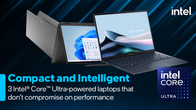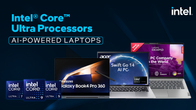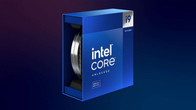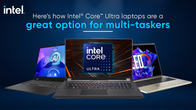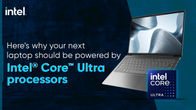
The Intel® Core™ ‘i’ branding has been with us for many years, just over 15 years actually. It was first introduced when the company unveiled its Nehalem microarchitecture back in November 2008. So when Intel® decides to change things up, you know it’s a big deal. The brand has introduced the new Intel® Core™ Ultra processors, which will now be Intel’s most premium offerings and will feature the best that the company has to offer.
Why change things around?
Well, the key reason for this name change is a groundbreaking advancement in chip design called the Intel® 4 process. The company claims that this represents its largest architectural shift in 40 years. It includes an all-new 3D performance hybrid design, Neural Processing Unit (NPU) and may also include Intel® Arc GPU for graphics. Aside from an increase in performance, the processor also allows for new AI-based capabilities such as real-time language translation, Windows Studio Effects, and more while also saving power. With so many new additions, a name change is warranted.
Catering to an AI future
So what is the big deal with AI? Well, it has the potential to impact almost every aspect of our daily lives. From productivity to creativity, it will be used everywhere and every day and these processors are specifically designed to handle AI tasks. This has been made possible by the addition of the NPU which is designed to work in tandem with the CPU and GPU. The NPU is called into action when dealing with high-end AI tasks, while the CPU and GPU are utilised for low-end tasks. Intel® calls its NPU Intel® AI Boost.
So what kind of AI tasks can the processor help with? Well, designers, marketing and advertisers will love the text-to-image feature that uses AI to create images with just a short text description. This can best be experienced when using software such as Blender or GIMP. Meanwhile, photo and video editors will love the new AI-based editing capabilities that allow for faster and more natural filters, better quality previews, and faster export times with the added benefit of automated and quicker searches. Those who use Adobe Lightroom or OBS Studio will surely appreciate this. Popular music editors like Audacity can offer features such as noise suppression, music suppression and text-to-music.
But AI is not just for creators. Professionals also have a lot to benefit from the inclusion of AI. They can experience increased productivity with next-gen video conferencing, streaming and collaboration while preserving battery life. For example, with Windows Studio Effects, users can make use of features such as Smart Scene Framing, Eye Gaze Correction, Low Power Background Blur and more. Users can also experience better personal assistance through software such as Rewind.
Of course, it’s not all work. Gaming and entertainment stand to get a boost as well. For example, AI could add a bunch of new in-game features, such as improved 3D animation for added realism or live transcription and chat translation for a better multiplayer experience. Other AI-based features that one can expect in gaming and entertainment are game upscaling with Intel® XeSS and gesture recognition.
But this is just the tip of the iceberg when it comes to the capabilities of an AI-powered PC. AI could also be used to help out when it comes to writing, coding and even text prediction. It can also help ensure your work is grammatically correct. That’s not all, AI will even help improve a PC’s security and privacy by taking note of any indicators of an attack and then automatically moving to protect vital data. Further, it could also improve security scans for better protection against a range of real-time threats. But that’s not all. An AI PC will also make things much easier for people with disabilities by utilising AI-assisted audio-visual capabilities for diverse needs. This makes it easier for everyone to be more productive.
What processors are on offer
Intel® is currently offering a total of 12 SKUs under the Core™ Ultra branding. Users can get up to a whopping 16 cores and 24 threads of performance. These processors also feature an updated version of the Performance Hybrid Architecture that Intel® has been using. In this new setup, the processors are divided into P-Cores, E-Cores and the new LP E-Cores with the LP standing for ‘Low Power’. This means that the new processors can offer even better performance and responsiveness with an even longer battery life.
The new Intel® processors are divided between the Core™ Ultra 9, Core™ Ultra 7, and Core™ Ultra 5 variants. The 9, 7 and 5 should give users a better idea of the performance capabilities of the processor. The Intel® Core™ Ultra 5 series is best suited for professionals and enhanced video calls as it can easily add AI-based effects. This could include things such as background blurring or automatic framing. But that’s not all. It can even help with things such as multitasking with AI-accelerated software and AI-enhanced gaming on the go.
However, video editors may want to consider the Intel® Core™ Ultra 7 processor. This can not only do pretty much everything that the Core™ Ulta 5 can do but with greater capability when it comes to AI-enhanced video editing. So things such as colour correction, background noise reduction, and so on would be much faster.
Then we have the Intel® Core™ Ultra 9. As it is one of the best on offer, it can easily take on most AI-based tasks that you can throw at it. But do note that as you increase the performance levels, the costs generally go up. So keep that in mind when purchasing.
So what does all this mean? Well, these processors can now offer low latency touch screens with QHD low power resolutions and HDR 500+ certified displays. So users get more responsive touch screens with increased visual fidelity that do not use as much battery power. Further, users can also expect smarter and more responsive Wi-Fi that supports Wi-Fi 6E and Wi-Fi 7 standards. Other improvements include improved camera quality during video conferencing. This is aside from the plethora of benefits brought forth by AI-based features which we have already talked about earlier.
What do the numbers mean?
As with past Intel® Core™ processors, all Core™ Ultra processors feature an alphanumeric numbering system to help differentiate the different SKUs. To know more about the new naming scheme, we first need to look at how Intel® used to name its processors. Let’s take the 13th Gen Intel® Core™ i7-13850HX processor as an example. The ‘i7′ denotes the brand level and should be the one most of us easily understand. The next two digits, which in this case is ‘13′, denotes the generation. The three digits after that, denote the SKU number, and higher numbers generally denote better performance, but only within the brand level. Finally, we have the alphabet suffix that denotes the product line and gives consumers an idea as to what the processor is designed for. In this case, the HX denotes that the processor offers the highest performance levels and is unlocked.
Now let’s look at the newer, shorter naming scheme for the Intel® Core™ Ultra Processors. We will use the Intel® Core™ Ultra 7 165U processor as an example. The ‘7′ here denotes the brand level and we have already talked about this in the section above. The ‘1′ after this is the series. As this is the first lineup of the Intel® Core™ Ultra Processors, it gets ‘1′. The lineup after this will get ‘2′, and the one after that will get ‘3′, and so on. The two digits after (65) are the SKU numbers with higher numbers generally offering better performance within its brand level. Finally, we have the alphabet suffix. Currently, The Intel® Core™ Ultra Processors only offer two suffixes, namely ‘H’ and ‘U’. The H-series offers higher performance levels, while the U-series is aimed at better power efficiency. The U-series tend to have a base TDP between 9W to 15W and are designed for ultra-thin and light laptops. The H-series features a base TDP greater or equal to 28W and is designed for laptops that feature fans for added cooling.
In conclusion, the debut of the Intel® Core™ Ultra processors not only signifies a shift in chip architecture but also introduces a streamlined naming convention. The new scheme aims to provide consumers with a clearer understanding of each processor’s capabilities and intended use. This simplified approach reflects Intel’s commitment towards easy identification in its product offerings, while also ushering in a new era of AI computing.

